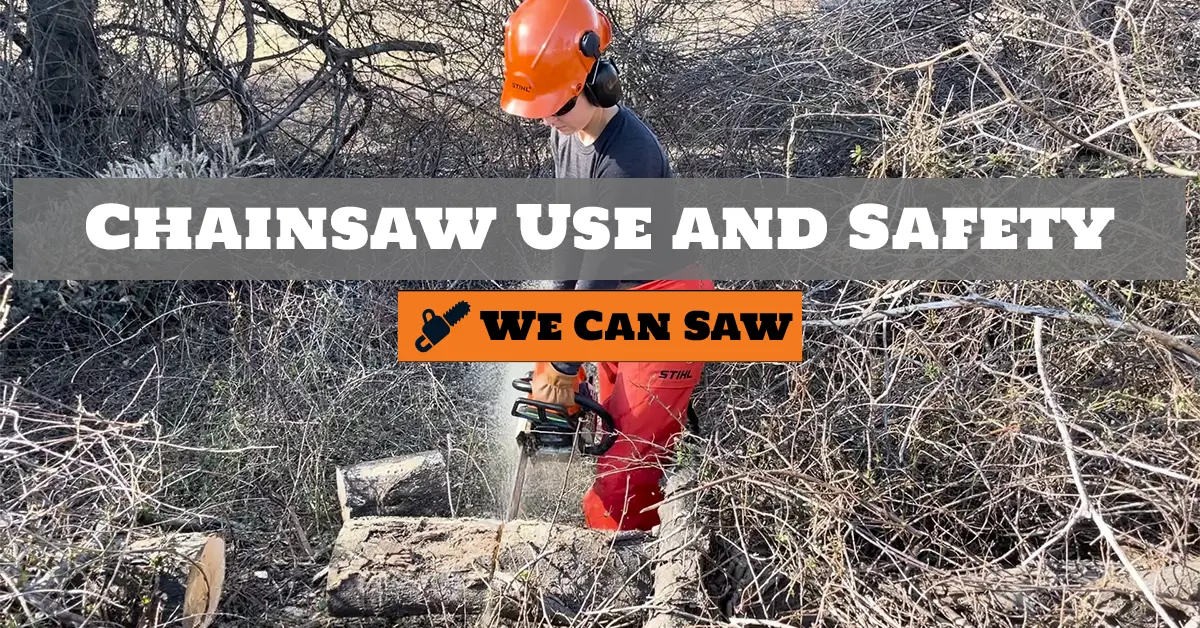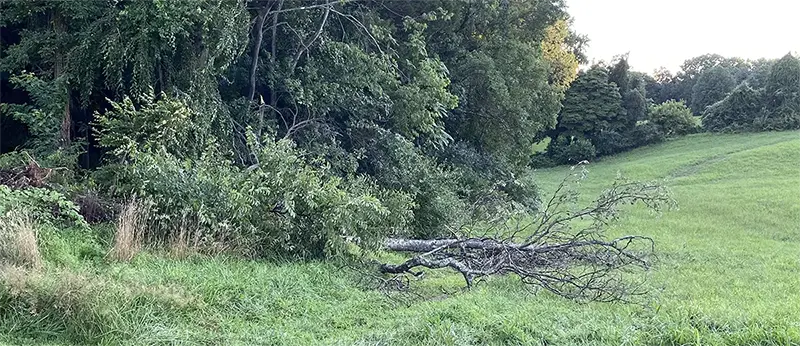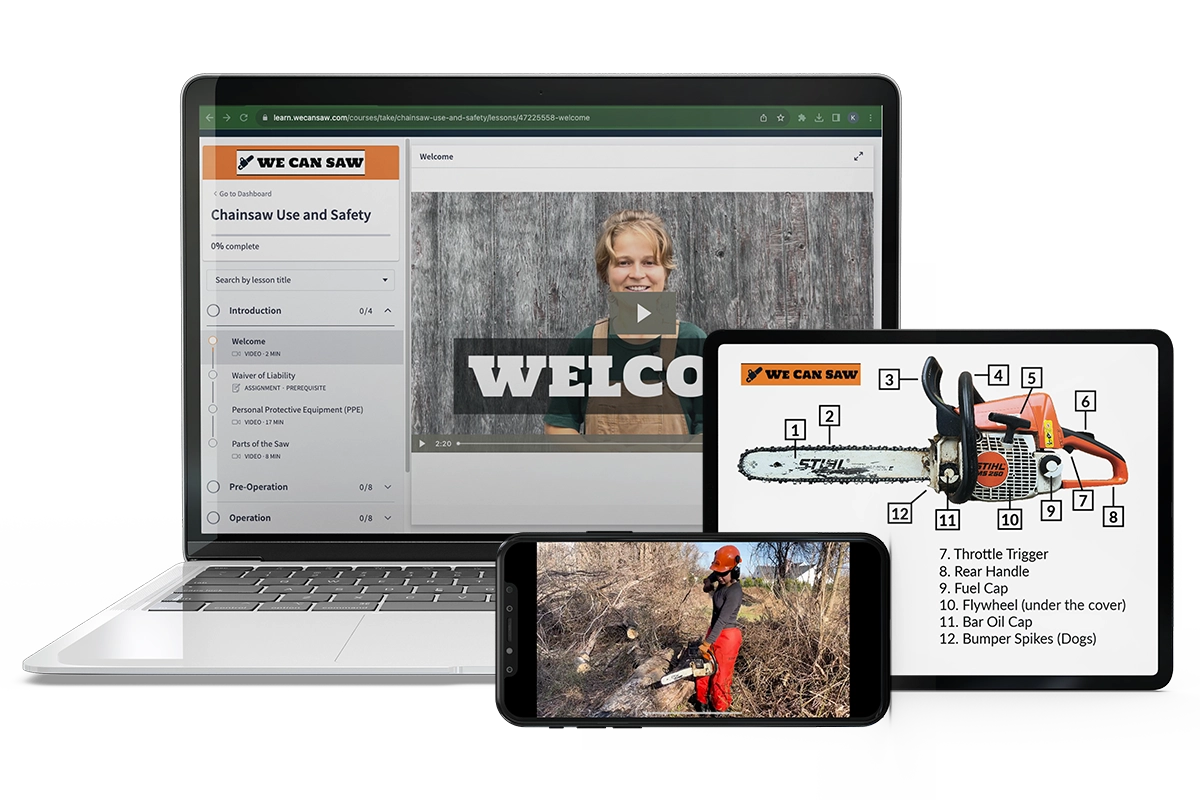Master Essential Chainsaw Skills and Safety Measures
The Only Online Chainsaw Course for Beginners
- Over 3 Hours of Expert Guidance
- No Pre-Requisites Required
- Safely Tackle Saw Projects on Your Property
- Save Hundreds, if Not Thousands, on Costly Tree Removal Services
- Get Started Today, Be Ready to Cut by Tomorrow
99% of Students Would Recommend this Course to a Friend
Kelly made me love the chainsaw! She showed me the ropes and made me feel supported. She helped me understand that it’s important to be cautious because that will save your life!
To the point. Safety first attitude. No bravado.
Clear, concise, practical.
Introducing:
The Chainsaw Use and Safety Course
The course consists of four sections: Introduction, Pre-Operation, Operation, and Maintenance.
These sections are divided into 20 engaging video and text-based lessons. Plus, you’ll have downloadable resources for handy reference.
The course takes a minimum of 3 hours to complete, and I recommend additional practice to hone your skills.
I review the course regularly to ensure it remains accurate and up-to-date.

What Exactly Will You Learn?
Introduction
- Important chainsaw parts. You’ll learn their purpose and location. If something goes wrong, you’ll be much better able to address the problem.
- The safety gear you need to protect yourself. Wearing the right safety gear is the easiest and most important thing you should do to stay safe while using a chainsaw.
- Common terms you’ll hear when discussing chainsaws – such as in this course. You’ll also sound confident when discussing chainsaws with your neighbors and friends.
Pre-Operation
- How to prepare a safe cutting environment. You’ll learn about overhead and on-ground hazards that you may not have thought to consider. In fact, overhead hazards cause more chainsaw-related injuries than actual chainsaws each year. You’ll be much safer practicing your new saw skills if you’ve reduced these risks as much as possible.
- How to identify widow makers. Widow makers are one of the leading causes of chainsaw-related accidents and injuries.
- What should be in your emergency plan? How can you safely get emergency help as fast as possible? If you have to call 911, what should you say? If you need a helicopter, where could it land?
- The emergency medical supplies you should have on you at all times while sawing. These items could be the difference between life and death should an accident occur.
- How to make sure you’re in a safe headspace. We’ll go over several questions you should ask yourself before starting a saw. These questions are also a great way to get focused on the task ahead.
- Physical checks you should do before using a saw. You don’t want to cause yourself an injury due to lack of preparation or poor timing.
- How to prepare your saw for use. You won’t ruin your saw by making easily avoidable mistakes.
- A little saying that’ll make sure you never mix up the fuel and oil valves (see minute 0:09 in Fueling your Chainsaw). Putting fuel in the wrong place is a common mistake that is a headache to clean up and can severely damage your saw.
- What chainsaw fuel to use. Unlike a car, you can’t put regular gasoline in your chainsaw. We’ll talk about what fuel to oil ratios to use and how to make sure you’re mixing them correctly.
- What to use to make sure your chain is properly lubricated so that it will cut smoothly.
- How to set and adjust your chain tension. Too tight chains can make it impossible to cut and they can lead to smoking, overheating and a ruined bar. A chain that’s too loose is extremely dangerous. If you try to cut with a loose chain, you run the risk of it flying off and hitting you.
Operation
- What kickback is and why it occurs (there’s a whole lesson dedicated just to kickback – it’s that important). Real quick – kickback is arguably the most dangerous force created by your chainsaw. Most severe head, neck and shoulder injuries are due to kickback.
- Three simple tricks for preventing kickback (see minute 0:39 in the lesson on kickback). Using a chainsaw that’s jerking all over the place like a bucking bronco is stressful and scary.
- My two part system to prepare for kickback if it does occur (see minute 2:41 in the lesson on Kickback). Kickback happens so quickly you won’t have time to respond. Either you’re ready or you’re not. This system makes sure you’re ready.
- The nine easiest ways to prevent common chainsaw hazards and injuries. If you can distill these tricks into habits you’ll be golden. Those habits could save your life.
- Proper body mechanics. You’ll be much less likely to develop an overuse injury or strain when you follow these guidelines.
- The best way to hold a chainsaw. Most saws are over 10 pounds, imagine holding a bowling bowl straight out in front of you. How long could you hold it before your arms gave out? Starting at minute 0:36 in the lesson on Sawing Sustainably, you’ll learn how to hold the saw so that you can easily do so for hours on end. And this is coming from a small weak(ish) woman.
- A simple trick professionals use that not only saves their muscles, but also helps the saw cut faster (see minute 3:35 of Sawing Sustainably).
- How to make sure you’re not straining your lower back while cutting. A lot of people use unsustainable body positions while cutting. Many of these people find themselves immobile on the couch the next day. It’s pretty easy to prevent this if you know what positions to avoid.
- How to start your chainsaw so that it’s not such a frustrating and intimidating process. You’ll be able to get to work instead of wasting time trying again and again to start the saw.
- Tips for how to start your saw even if you’re a small person with little strength. I go over the specific method I use as a small 120 pound woman in minute 0:36 of Starting Your Chainsaw. I can start saws as easily as my stronger male colleagues. Sometimes, they even come to me for help.
- When to switch your saw from full choke into half choke while starting your saw. You’ll learn what the all-important “burp” sounds like at minute 4:42 of Starting Your Chainsaw.
- How to avoid flooding your engine. It’s not fun to have to set the saw aside and wait 20 minutes when all you want is to get started.
- Does your saw have a decompression valve or a purge pump? You’ll learn about the different types of saws and how to start each one.
- How to cut up a tree into logs with such ease that your neighbors might come to you for help. You’ll be able to easily clear your driveway or nearby backroads, cut limbs off of fences, etc.
- How to safely deal with storm-damaged trees. What should you look for when dealing with a tree that got uprooted? Is there a specific way you should handle two trees that fell on top of one another? Storm-damaged trees are particularly hazardous, but once you know what to look for they’ll be no problem. See minute 1:48 of Bucking and Limbing.
- How to actually make a cut. Do you pull the trigger while the saw is touching the wood or a bit above it? How much do you pull the trigger? Do you need to move the saw back and forth like you would with a handsaw? All of these questions and more are answered in the lesson titled Your First Cut. Small details like these are the difference between a smooth effortless cut and your saw stopping for no reason.
- Does your chain get dull shortly after you start cutting? Does your saw work smoothly at first…but after a few minutes you have to force your saw through the wood? We’ll talk about some common reasons why this happens and how to prevent it at minute 2:08 of Your First Cut.
- How to cut logs that are lying flush on the ground having to touch your saw to the dirt (see minute 4:41 of Bucking and Limbing).
- How to know which cuts to use and where to stand so that the log won’t spring back and injure you. Fallen trees especially have a lot of stored tension that can be released when cut. See the story below about my friend who almost lost his life if you don’t believe me.
- Ways to avoid getting your saw pinched by different types of trees (see minute 5:38 of Reading Trees). Every beginner knows the feeling. You’re cutting and everything’s going great, then all the sudden your saw is stuck. It happens in the blink of an eye. Getting it unstuck can be quite the hassle.
- You’ll learn how to read the patterns of tension and compression in trees. This will give you clues about which cuts to make and in what order. This will keep you safe and prevent your saw from getting stuck.
- One simple trick that’ll help you make sure your saw doesn’t get stuck even if you can’t tell what cuts you should make. And it’s not using wedges, although those could help. See minute 4:48 of Reading Trees.

Trees knocked over during storms are particularly hazardous, but once you know what to look for they’ll be no problem.
Basic Maintenance
- How to clean your saw. You’ll learn which parts you should clean each time you use the saw and how to disassemble the saw to reach those parts (see minute 0:42 of Daily Maintenance). You’ll be able to keep your saw in tip-top shape so it’ll be useful for years to come.
- What tools you need to sharpen and maintain your saw. You’ll learn what each tool is used for and which ones you need for your specific saw.
- How often to clean your air filter. You’ll also learn the one thing most people forget to do before cleaning out air filters that could damage their engines over time (see minute 0:55 of Maintenance).
- How to check your bar for issues and fix them before they become irreversible. Bar issues could cause your saw to cut lopsided or even prevent it from cutting at all.
- How to untangle your chain. Have you ever taken your chain off of your chainsaw and ended up with a mangled mess of loops? Untangling them can feel like trying to solve a Rubik’s cube, but it’s simple if you know the trick I teach you in minute 0:30 of Putting Your Bar and Chain On.
- How to reassemble your saw after you take it apart. Getting the bar and chain back on a saw after cleaning can be difficult. I’ll teach you the method I use so things don’t become a frustrating mess.
- Why your bar nuts keep coming unscrewed while you’re cutting. If you use my tightening sequence, this won’t be an issue (see minute 5:28 of Putting Your Bar and Chain On).
- How to keep your chain so sharp that no one can doubt your competency. Not only does a sharp chain make your work easier and faster, but a sharp chain is a safe chain.
- What body positions you can use to stay comfortable while sharpening your chain. You don’t need a vice grip or expensive tools to be able to sharpen a chain on your own (see minute 4:26 of Sharpen Your Saw).
- How and when to file your depth gauges. Over-filing can make your saw overly aggressive and lead to increased kickback. Under-filing them can lead to a saw that doesn’t cut. I’ll help you find the goldilocks point.
Designed to Work With Your Busy Lifestyle.
You’re busy and don’t have much, if any, time to spare. That’s why this course fits in with your schedule. It makes learning to use a chainsaw as effortless as possible.
- Start learning immediately. No need to pull out your calendar to block off a weekend sometime in the distant future.
- Watch lessons on any device. The course is compatible with your mobile device, computer, or tablet.
- Learn wherever and whenever you choose. You can watch lessons inside sitting on your couch or outside next to that fallen tree in your yard.
- Pause the course whenever you choose. Your progress is automatically marked as you take the course.
- Lessons are to the point with no fluff. You won’t have to skip through 30 seconds of pointless intros.
- Receive unlimited access to the course – forever. You can revisit lessons whenever you want and you’ll be able to use the course year after year to brush up on your skills.
- Feel confident with my 100% money-back guarantee. If it doesn’t work, I’ll refund you. Simple as that.
Meet Your Instructor
Hello, I’m Kelly Foulk, your chainsaw instructor.
I may not fit the stereotype of a typical chainsaw instructor—I’m a petite 5’4″, 120-pound woman. But…
- I can expertly handle various saws, from small STIHL MS 170s to heavy STIHL MS 460s.
- I’ve felled trees over a hundred feet tall with trunks several feet wide.
- I’ve worked as a sawyer on high-intensity wildland fires, cutting down burning trees.
My limited strength and size are my strengths. They give me a unique perspective, ideal for teaching beginners.

This Simple Decision Could Save You Thousands of Dollars a Year
Think about the money you’ve shelled out for tree removal and firewood in recent years. It adds up, doesn’t it?
Now, picture this scenario: Next Monday, a powerful storm descends, toppling three trees on your property. The standard cost for professional cleanup and tree removal hovers around $2250.
Quite a sum, isn’t it?
But that’s not all. If it’s a major storm affecting a wide area, you might find yourself waiting for more than a week before the tree service can reach you. Not ideal, especially if those fallen trees are blocking your car.
However, here’s the game-changer: being able a chainsaw.
With this valuable skill, you can swiftly clear those fallen trees, saving a whopping $2250. What’s more, you can transform that timber into logs, ready to fuel your home during the winter months.
This course is your ticket to acquiring these crucial chainsaw skills, all available right now for just $97.
Consider this:
With a single storm, you’ve recouped over $2000 in potential savings.
When you purchase this course today and dedicate your weekend to it, you’ll be primed and prepared to tackle that storm on Monday—and every storm that follows.

The Beginner Chainsaw Course
- Master the essential safety skills you’ll need to use a chainsaw.
- Over 3 hours of expert guidance
- Comprehensive lesson plan covering my CutSafe Protocol, bucking, limbing, and more.
- Learn online wherever and whenever you want.
- Receive unlimited access to the course – forever. Revisit lessons whenever you want.
- FREE Chainsaw Troubleshooting eBook
- Feel confident with my no nonsense money-back guarantee.

Feel Confident or Your Money Back
I’m confident that this course will equip you with the essential chainsaw skills you need. However, if you’re not satisfied with your purchase for any reason within the first 30 days, I’ll refund your money – no questions asked.
Bonus eBook:
Chainsaw Troubleshooting Made Easy: A Beginner’s Guide
$18 value
Don’t worry if you’re not mechanically inclined. This book is designed to be so straightforward and simple your 10 year-old could use it.
This eBook will save you time and money. No more going to professionals for things you could do yourself.
What People Are Saying…
Kelly breaks the aspects of cutting down to a simple, easy to digest method that is foolproof. She understands what it is like to be a beginner sawyer in a fast moving environment. This allows her to be able to relate and help everyone to become confident with a saw.
Kelly is extremely driven and passionate and she brings this to her teaching. She is a confident teacher which spills over into creating confidence in her students. Her patience stands out. She meets you where you are and works with you until you reach the level you desire.
Kelly has showcased her innate ability to foster learning time and time again. She is a supportive and passionate teacher. She takes the time to make individual students feel recognized and challenged
This Course Could Save Your Life
Tens of thousands of people get hurt in chainsaw accidents every year. Many of those are easily avoidable.
Don’t be one of those people who get hurt doing something obvious.
You have two options right now:
Option 1: Try to figure it out on your own.
Don’t worry about safety or learning how to do things properly. Cross your fingers each time you turn your saw on, hoping you’ll be okay. Learn things the hard way.
Option 2: Learn from a professional.
Sign up for this course and start today. In your very first lesson you’ll learn the easiest way to protect yourself from all chainsaw injuries. If this course does not prove useful, you’re protected by my no-nonsense 30 day gaurantee – I’ll send your money back ASAP.
It’s a no-brainer.
Frequently Asked Questions
Is this course suitable for complete beginners with no prior chainsaw experience?
Absolutely! This course is designed specifically for beginners with no prior experience. The step-by-step lessons and instructional videos will guide you through the entire learning process.
What makes this course different from free YouTube tutorials or other online resources?
This course is comprehensive and structured, ensuring you cover all essential aspects of chainsaw operation systematically. Plus, you’ll have access to expert support and exclusive downloadable resources.
Can I access the course materials after I've completed it?
Yes, once you’ve completed the course, you’ll have lifetime access to all the materials and updates, so you can revisit the content whenever you need a refresher.
What is your refund policy?
I’m confident that this course will equip you with the essential chainsaw skills you need. However, if you’re not satisfied with your purchase for any reason within the first 30 days, I’ll refund your money – no questions asked.
Can children register for your course?
The course is only for adults age 18 and older.
How do I enroll in the course and get started?
Simply press “Join Waitlist” and when a spot opens up, I’ll let you know.
